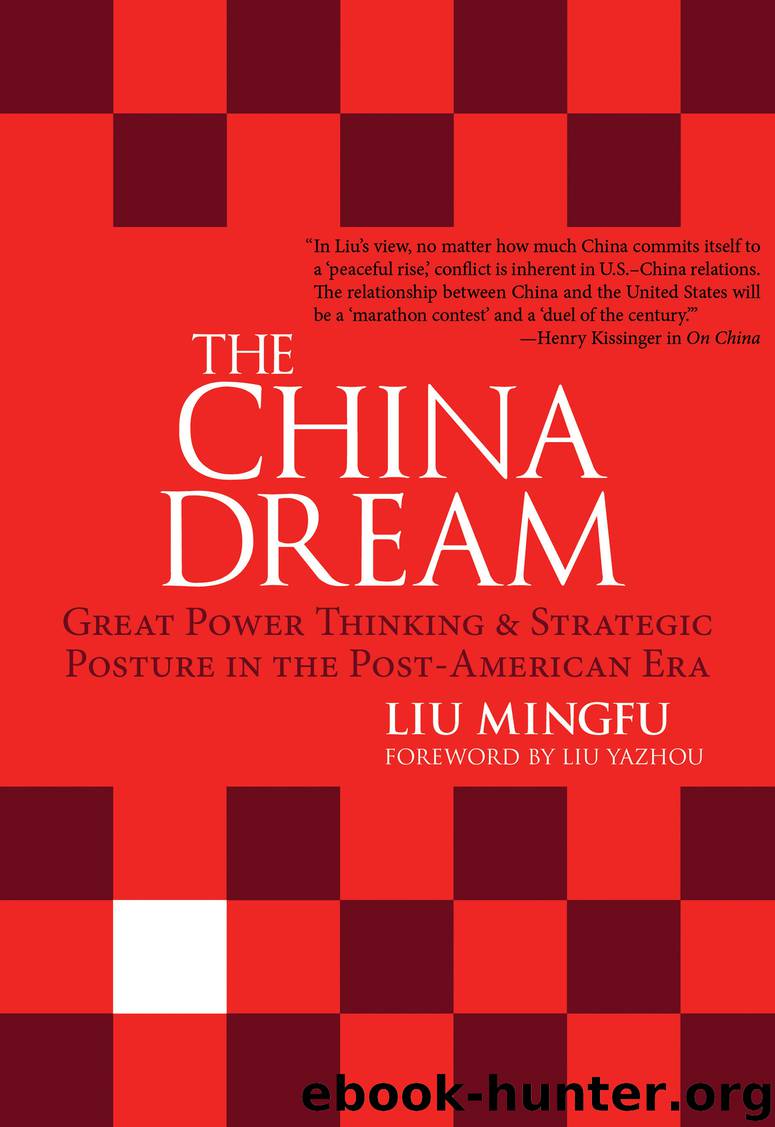The China Dream: Great Power Thinking and Strategic Posture in the Post-American Era by MIngfu Liu;

Author:MIngfu, Liu;
Language: eng
Format: epub
Publisher: CN Times Books Inc.
Published: 2015-01-09T16:00:00+00:00
War Preparation
The United States, guided by the knowledge that there are no permanent friends or enemies, only permanent national interests, was thoroughly ready for war during its dealings with both friends and enemies as it rose, even with its ally the United Kingdom in the First World War.
During World War I America faced competition for control of the oceans from the UK and Japan. In 1919 America’s Joint Army and Navy Board met with the War Department to discuss possible British attitudes. The Joint Army and Navy Board believed that the possibility for conflict existed between the US and the UK, and that if the UK launched a war against the US, Japan would not hesitate to join on the side of the UK. In March 1920 the United States produced two war plans: one was the Orange Plan for war in the Pacific against Japan, the second revision of 1911’s Orange Plan; the other was the Red-Orange Plan, a plan for a war in the Atlantic against the UK and in the Pacific against Japan. In the war plan, it’s clear the board believed a Britain-Japan alliance would not just directly influence US strength in the Pacific region, but also influence America’s strategic position globally. America would have to distribute its fleet over both oceans.
From 1922 to 1924 the United States Navy made this judgment regarding its war plans in its annual reports: Japan and the United Kingdom are still countries capable of competing with the United States for naval supremacy, and the risk of an evenly matched contest with one or both still exists. The United States Navy should first prepare for war against Japan, and second for a war against Britain or an Anglo-Japanese alliance.
In the interwar world of the 1920s and 1930s the nation most likely to go to war with the United States was Japan. We believe that is the most likely war to happen, and the Orange Plan was America’s most important military plan. The plan was kept in place for more than ten years, and although it was modified several times, the core strategy of preparing to conduct a unilateral Pacific offensive against Japan never changed.
In the later interwar period, the United States began to alter its strategic war plans. In the 1938 revision to the Orange Plan, beyond maintaining the original plan for an offensive war in the Pacific against Japan, the plan began to include a possible Atlantic threat from Italy and Germany. In February 1939 Roosevelt proposed strengthening 16 foreign naval bases to Congress, and of these 16, there were three times more in the Pacific region than the Caribbean. This showed that American strategy was still focused on the Pacific theater. It was only after Germany occupied Czechoslovakia in March 1939 and then made territorial claims against Poland in April 1939 that the Joint Chiefs of Staff issued a report pointing out the threat from the Atlantic. The report suggested taking a defensive posture in the Pacific and using Hawaii as a base, holding the strategic triangle (Hawaii – Alaska – Panama).
Download
This site does not store any files on its server. We only index and link to content provided by other sites. Please contact the content providers to delete copyright contents if any and email us, we'll remove relevant links or contents immediately.
| Arms Control | Diplomacy |
| Security | Trades & Tariffs |
| Treaties | African |
| Asian | Australian & Oceanian |
| Canadian | Caribbean & Latin American |
| European | Middle Eastern |
| Russian & Former Soviet Union |
The Secret History by Donna Tartt(18854)
The Social Justice Warrior Handbook by Lisa De Pasquale(12143)
Thirteen Reasons Why by Jay Asher(8800)
This Is How You Lose Her by Junot Diaz(6800)
Weapons of Math Destruction by Cathy O'Neil(6149)
Zero to One by Peter Thiel(5691)
Beartown by Fredrik Backman(5603)
The Myth of the Strong Leader by Archie Brown(5429)
The Fire Next Time by James Baldwin(5250)
How Democracies Die by Steven Levitsky & Daniel Ziblatt(5132)
Promise Me, Dad by Joe Biden(5088)
Stone's Rules by Roger Stone(5027)
A Higher Loyalty: Truth, Lies, and Leadership by James Comey(4851)
100 Deadly Skills by Clint Emerson(4845)
Rise and Kill First by Ronen Bergman(4705)
Secrecy World by Jake Bernstein(4652)
The David Icke Guide to the Global Conspiracy (and how to end it) by David Icke(4629)
The Farm by Tom Rob Smith(4442)
The Doomsday Machine by Daniel Ellsberg(4420)
